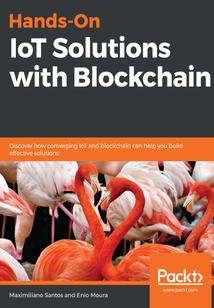舉報 

會員
Hands-On IoT Solutions with Blockchain
Blockchainhasbeenthehottopicoflatethankstocryptocurrencies.Tomakemattersmoreinteresting,thefinancialmarketislookingforwaystoreduceoperationalcostsandgeneratenewbusinessmodels,andthisiswhereblockchainsolutionscomeintothepicture.Inadditiontothis,withInternetofThings(IoT)trendingandArduino,RaspberryPi,andotherdevicesfloodingthemarket,youcannowcreatecheapdevicesevenathome.Hands-OnIoTSolutionswithBlockchainstartswithanoverviewofIoTconceptsinthecurrentbusinessscenario.ItthenhelpsyoudevelopyourowndeviceontheIBMWatsonIoTplatformandcreateyourfirstIoTsolutionusingWatsonandIntelEdison.OnceyouarefamiliarwithIoT,youwilllearnaboutBlockchaintechnologyanditsusecases.YouwillalsoworkwiththeHyperledgerframeworkanddevelopyourownBlockchainnetwork.Asyouprogressthroughthechapters,you'llworkwithproblemstatementsandlearnhowtodesignyoursolutionarchitecturesothatyoucancreateyourownintegratedBlockchainandIoTsolution.Thenextsetofchapterswillexplainhowtoimplementend-to-endBlockchainsolutionswithIoTusingtheIBMCloudplatform.Bytheendofthisbook,youwillhavemasteredtheconvergenceofIoTandBlockchaintechnologyandexploitedthebestpracticesanddriverstodevelopabulletproofintegratedsolution.
目錄(192章)
倒序
- coverpage
- Title Page
- Copyright and Credits
- Hands-On IoT Solutions with Blockchain
- About Packt
- Why subscribe?
- Packt.com
- Contributors
- About the authors
- About the reviewers
- Packt is searching for authors like you
- Preface
- Who this book is for
- What this book covers
- To get the most out of this book
- Download the example code files
- Download the color images
- Conventions used
- Get in touch
- Reviews
- Understanding IoT and Developing Devices on the IBM Watson IoT Platform
- What is IoT?
- Common business use cases of IoT
- Connected car
- Connected persons
- Technical elements in IoT
- Devices
- Edge computing
- Networking
- Wireless (Wi-Fi) or cabled network
- Cellular/mobile network
- Low-power wide-area network (LPWAN)
- LoRa or LoRaWAN
- Network summary
- Application protocols
- MQTT
- Analytics and AI
- IBM Watson IoT Platform features
- Features
- Dashboard
- Devices gateways and applications
- Security
- Creating your first IoT solution
- Creating a gateway
- Creating an application
- Creating a device
- Summary
- Further reading
- Creating Your First IoT Solution
- Technical requirements
- The first IoT solution – the gardening solution
- Requirements overview
- Solution overview
- Selecting the equipment
- Intel Edison
- Arduino breakout board
- Grove system
- Grove base shield for Arduino
- Grove sensors
- Grove button
- Grove relay
- Wiring the device
- Coding the device firmware
- Measuring soil moisture
- Measuring environmental temperature
- Turning on the relay
- Publishing events
- Monitoring the events
- Subscribing to actions
- Creating the backend application
- Creating a Cloud Foundry application in the IBM Cloud Platform
- Uploading the code
- Summary
- Further reading
- Explaining Blockchain Technology and Working with Hyperledger
- What is blockchain?
- Blockchain and Hyperledger
- Hyperledger projects
- Hyperledger Sawtooth framework
- Hyperledger Iroha framework
- Hyperledger Composer tool
- Hyperledger Burrow framework
- Hyperledger Fabric
- Member or peer
- Certificate Authority (CA)
- Ordering Cluster
- SDK/API
- Selecting a good use case
- Blockchain – food tracking use case
- Summary
- Questions
- Further reading
- Creating Your Own Blockchain Network
- Prerequisites
- Creating your own blockchain network with Hyperledger Composer
- Accessing Hyperledger Composer
- Exploring the structure of a sample blockchain network
- Installing your own blockchain network using Hyperledger Fabric and Composer
- Setting up Docker
- Installing Hyperledger Composer
- Components
- Step 1 – Setting up CLI Tools
- Step 2 – Setting up Playground
- Step 3 – Hyperledger Fabric
- Step 4 – IDE
- Installing Hyperledger Fabric 1.3 using Docker
- Deploying Hyperledger Fabric 1.3 to a Kubernetes environment
- Summary
- Further reading
- Addressing Food Safety - Building around the Blockchain
- Regulations challenges and concerns in the modern food chain
- Challenges regarding food safety
- Food safety regulations – ISO 22000
- How blockchain and IoT can help in a food chain
- Food ecosystem
- Opportunities and challenges in a food ecosystem
- Farmers
- Food manufacturers
- Regulators
- Transporters (transportation companies)
- Stores and supermarkets
- Customer
- Is the food chain a good use case for IoT and blockchain technology?
- Summary
- Further reading
- Designing the Solution Architecture
- The business of food
- Challenges of the process
- The process at the food factory
- The process at the distribution center
- The process at supermarkets and stores
- The technological approach
- Frontend applications
- IoT-based asset tracking
- API/SDK
- Hyperledger Composer – a high-level overview
- Software components
- Composer REST server
- Hyperledger Composer model
- The Hyperledger Composer access control language
- Hyperledger Composer transaction processor functions
- Summary
- Questions
- Further reading
- Creating Your Blockchain and IoT Solution
- Technical requirements
- Solution overview
- Creating a blockchain network
- Concepts and enumerations
- Asset definitions
- Participants
- Deploying and testing the business network for Hyperledger
- Manipulating assets via transactions in the blockchain
- Generating and exporting participant business cards
- Defining access control lists (ACLs)
- Upgrading the business network to a newer version
- Setting up Composer REST servers for each participant
- Creating the IoT part of the solution
- Hardware setup
- Firmware development
- Application development
- End-to-end testing
- Creating a FoodBox
- Transferring the asset to the transporter
- Measuring the temperature while transporting
- Transferring the asset to the warehouse
- Creating a pallet and adding the box to it
- Measuring the temperature while transporting a pallet
- Tracking the FoodBox
- Summary
- The IoT Blockchain and Industry 4.0
- Industry 4.0
- Cloud computing as an innovation platform
- The cloud computing model
- The importance of cloud computing to Industry 4.0
- The IoT
- Blockchain – simplifying business chains
- Summary
- Best Practices for Developing Blockchain and IoT Solutions
- Developing cloud applications
- Reference architecture
- Development using the 12–factor application model
- Serverless computing
- Blockchain development using Hyperledger Composer
- The Hyperledger Composer toolkit
- The Hyperledger Composer REST server
- Authentication and multiuser mode
- Data source configuration
- Summary
- Further reading
- Other Books You May Enjoy
- Leave a review - let other readers know what you think 更新時間:2021-07-02 14:28:04
推薦閱讀
- 線性代數選講
- 小數學家應該知道的數學故事
- 瘋狂的數學游戲
- 有限自動機理論
- Data Visualization:a successful design process
- 一定要懂博弈論
- 別說你不懂數學
- 數字、代數和圖象(全彩版)
- Hands-On IoT Solutions with Blockchain
- 愛情數學(TED 思想的力量系列)
- 你沒想到的數學
- 經濟數學(二):線性代數、概率論及數理統計
- ABAQUS 2018有限元分析從入門到精通
- 給孩子的數學思維課
- 微積分的力量
- 周髀算經
- 在動手實驗中學習科學與數學
- 數學簡史
- 不焦慮的數學:孩子怎么學,家長怎么教
- 高職數學
- 博弈論:決策制勝的法則(萬物皆數學)
- ANSYS Workbench 16.0超級學習手冊
- 微積分的歷程:從牛頓到勒貝格
- π的秘密:關于圓的一切(萬物皆數學)
- 趣味數學
- 每天學點速算技巧(最強大腦思維訓練系列)
- 燒掉數學書:重新發明數學
- Hands-On Blockchain for Python Developers
- 貝葉斯方法:概率編程與貝葉斯推斷
- 數學的故事

